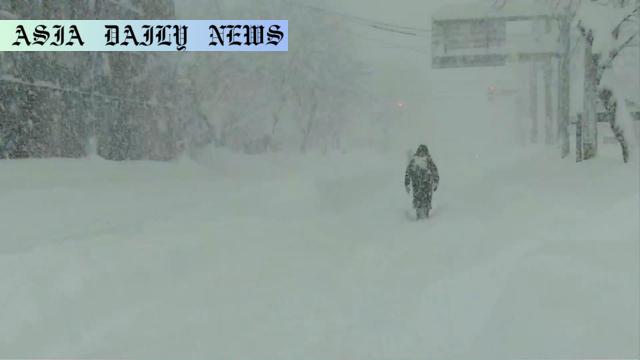Hokkaido Snowfall: Heavy snow in Hokkaido may increase due to global warming, with researchers predicting larger annual accumulations.
Researchers found that global warming could increase heavy snowfall in Hokkaido by 1.4 times.
Higher seawater temperatures create more vapor, leading to increased snowfall in colder winters.
Simulations suggest that once-a-decade heavy snow could occur annually under a warmer climate.
Residents are urged to prepare for more frequent and intense snowfall.

Introduction
Global warming is known to bring numerous changes to weather patterns across the globe. Contrary to what many might expect, its impact does not only entail warmer temperatures but also extreme cold weather scenarios. A recent study led by Kawase Hiroaki of the Meteorological Research Institute provides insight into how climate change could result in more frequent heavy snowfall in Hokkaido, Japan’s northernmost prefecture.
Unexpected Side Effect: More Snow, Not Less
Hokkaido, a region already accustomed to snowy winters, could experience unprecedented snowfall levels as global warming progresses. According to the study, the frequency of heavy snowfalls classified as “once-in-a-decade” events could increase by 1.4 times in a warmer climate. This seemingly paradoxical phenomenon is attributed to higher seawater temperatures. Warmer oceans produce more water vapor, which, when exposed to Hokkaido’s frigid winter temperatures, results in heavier snowfalls rather than rain.
Recent Record-Setting Snowstorms
The winter seasons from 2021 to 2022 and the ongoing 2023 winter have already shown glimpses of what the future might hold. In one instance, Sapporo City recorded 60 centimeters of snow within 24 hours, a new high for the city. Similarly, the Tokachi region faced an unexpectedly heavy snowfall this season, echoing the researchers’ grim findings.
Implications for Hokkaido Residents
As the likelihood of extreme snowstorms increases, the implications for local populations are significant. From disruptions to transportation systems to challenges in maintaining infrastructure, the region must prepare to adapt. Emergency measures and urban planning will need to consider these new climate realities. Residents are urged by Kawase and his team to brace themselves for sudden and intense snowfalls, potentially disrupting daily life more frequently than ever before.
Scientific Models Confirm the Trend
The study conducted by Kawase’s team utilized simulations comparing climate conditions pre- and post-Industrial Revolution. This comparative approach revealed that global warming amplifies weather extremes. The increased frequency and volume of snowfall in Hokkaido provide tangible evidence of this. Unlike other areas where global warming results in less snow and more rain, Hokkaido’s cold climate turns rising humidity levels into snowfall.
Preparing for the Future
To avert potential disasters, Hokkaido must take proactive steps. This includes better snow management systems, investments in weather prediction technology, and public awareness campaigns. The findings from this study should serve as a valuable resource for policymakers, guiding their decisions to ensure the safety and sustainability of affected regions.
Conclusion
The link between global warming and increased snowfall in Hokkaido emphasizes the complexity of climate change’s impact. It challenges misconceptions that warming simply leads to less snow and prompts a reevaluation of how we prepare for, and mitigate, climate-related risks. Kawase’s study highlights an urgent need for informed action to tackle the challenges posed by an ever-changing climate.



Commentary
The Link Between Global Warming and Snowfall
The findings from Kawase Hiroaki’s team challenge our preconceived notions about global warming. The idea that increased temperatures could lead to more snowfall, especially in colder regions like Hokkaido, is both surprising and fascinating. This demonstrates the unique and unpredictable ways in which climate change impacts our planet.
Impacts on Local Communities
Heavy snowfall, while picturesque, has real-world consequences. In Hokkaido, residents may face challenges with transportation disruptions, an increased risk of structural damage, and even threats to public safety. The prospect of once-a-decade storms occurring annually necessitates proactive planning to minimize risks and ensure the region’s infrastructure can handle these extreme conditions.
Adaptation and Planning for the Future
This study underscores the need for forward-thinking solutions as part of climate adaptation strategies. While reducing global emissions remains critical, regional governments must also focus on mitigating immediate risks. In Hokkaido’s case, this might include improving snow-clearing systems, creating public awareness campaigns on emergency preparedness, and investing in resilient infrastructure.
Final Thoughts
Hokkaido’s story serves as a reminder of the diverse ways global warming can shape local climates. It is not just about rising temperatures but also more extreme and unpredictable weather patterns. Kawase’s study should prompt other regions to assess their climate vulnerabilities and implement targeted solutions to safeguard their communities. There is no one-size-fits-all answer, but by acting now, we can reduce the potential fallout of these unpredictable changes.